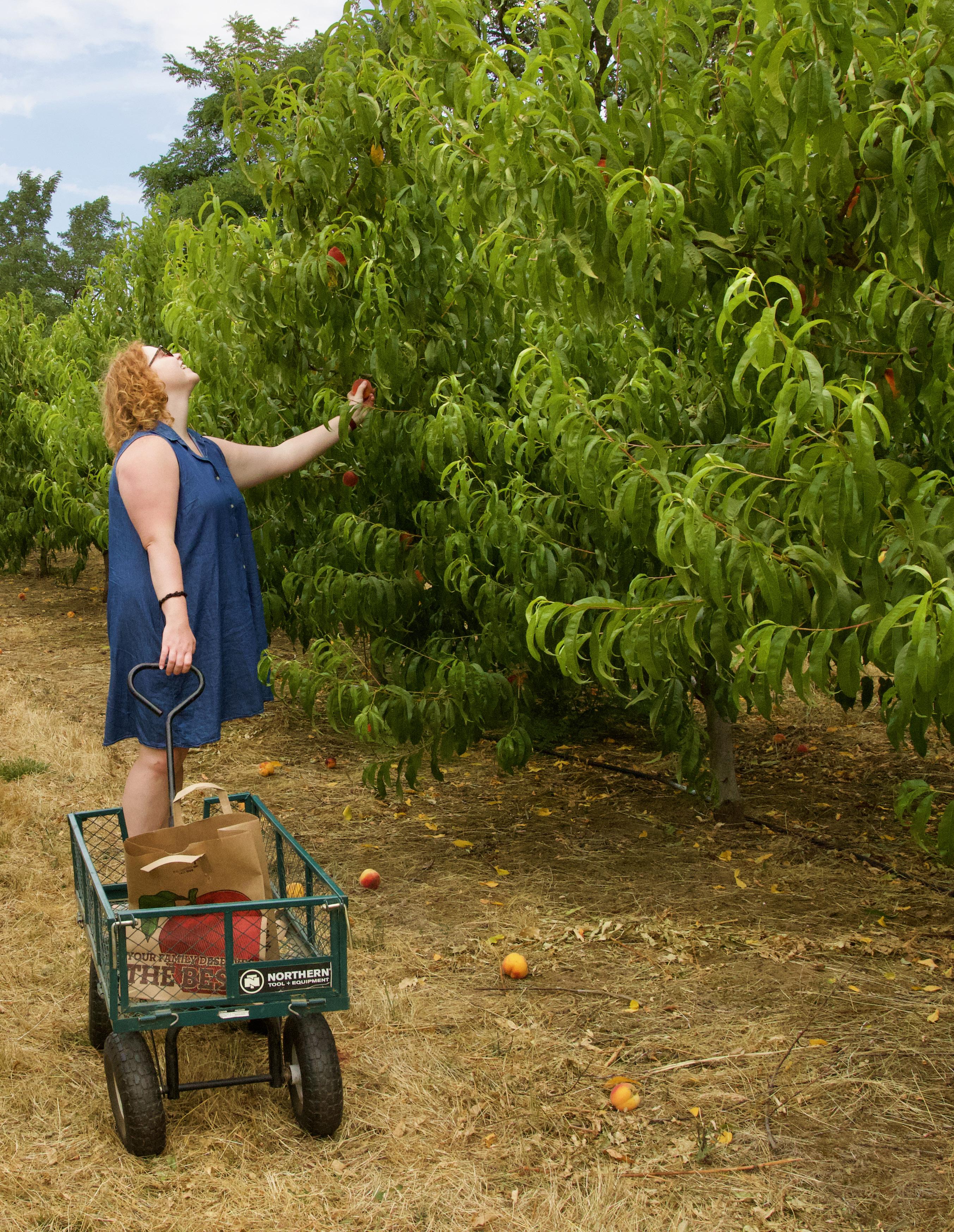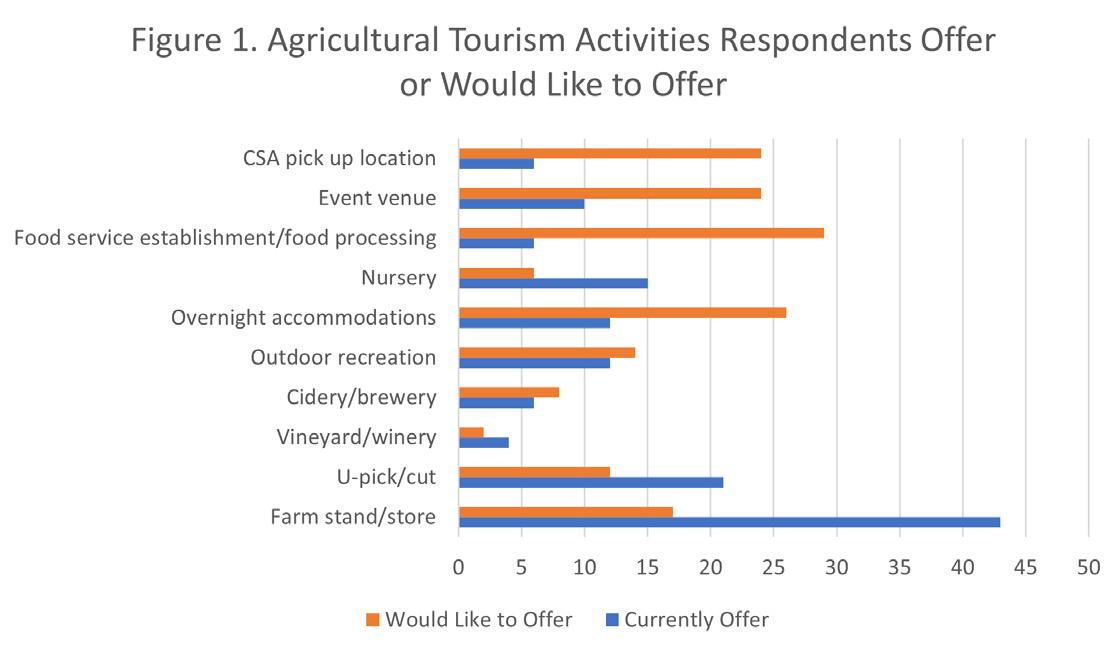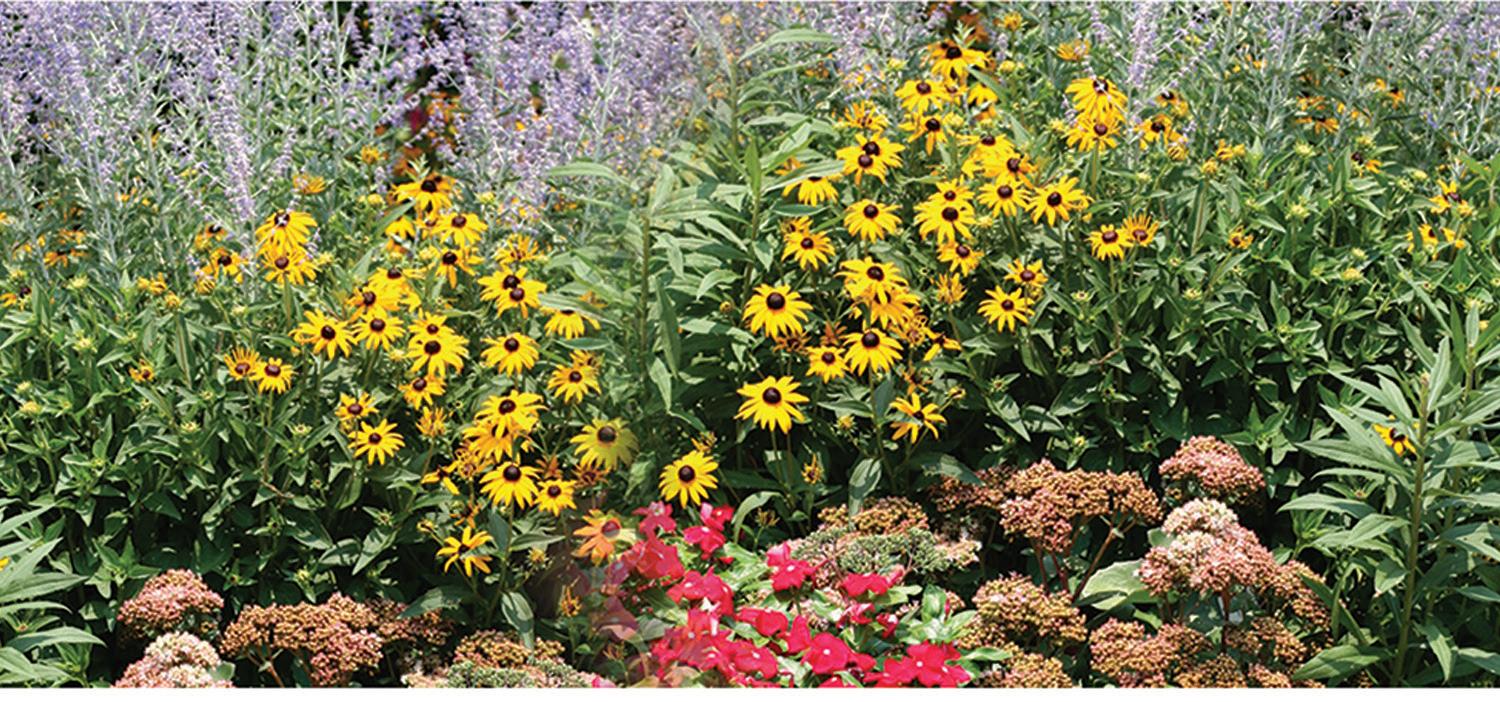
5 minute read
Oregon Producers
Continue to Look to Diversify Through Agricultural Tourism
BY AUDREY COMERFORD & MELISSA FERY OSU Extension Small Farms
Advertisement
Last December and January, we asked agricultural producers in the Willamette Valley whether their farming operation incorporates some form of agricultural tourism and farm-direct sales or if they are planning to in the future.
Ninety-eight Oregon farmers participated in the survey. Producers in six Oregon counties were targeted for the survey: Yamhill, Polk, Marion, Linn, Benton, and Lane. Their farming experience included beginning farmers who have been in business less than 5 years (17%), those who have been farming for more than 20 years (38%) and many in-between. The number of acres the respondents farmed also varied, ranging from less than 5 (27%) to more than 50 acres (32%). As expected, the range of crops produced by the survey participants was large. The top ten ranked were vegetables, berries, tree fruits or nuts, herbs, poultry for eggs, grapes, cut flowers, pasture/forage/hay, nursery stock, and bees.
Some key findings from the survey are shared below to bring awareness of types of on-farm activities and challenges of opening farms up to the public.
DEMOGRAPHICS
The majority of the respondents are already engaged in some form of agricultural tourism, with 74% saying yes and 26% no. Out of those currently not engaged in agricultural tourism, 52% of those plan to and 33% are considering the option.
Of those that are currently engaged with agricultural tourism, a majority (42%) have been doing so for more than 10 years. Table 1 shows the number of years each respondent has been participating in agritourism.
Number of years engaged in agritourism 1-2 years 3-4 years 5-6 years 6-10 years
More than 10 Number of respondents
12 7 12 5 6
Table 1. Years of Experience with Agritourism
Survey participants indicated which agricultural tourism activities they are currently offering as a part of their agritourism business and which they anticipate offering in the future. See Figure 1.
Respondents also shared information about the indi-
vidual agritourism activities they offer or would like to offer in the future, see Table 2.

Table 2. Individual Agricultural Tourism Activities
Agritourism Activities
Tours
Currently Offer Would Like to Offer
28 17
Small private events
22 Livestock/farm animals on display 19 Display gardens 17
Open farm days
16 Classes/workshops/demonstrations 13 Festivals (harvest, flower, etc.) 13 Promotional events 11 27 16 10 23 34 18 21
Tastings Hiking trails Birding Farm to table dinners Horseback riding 11 8 6 5 0 11 11 13 23 5
VALUE-ADDED PRODUCTS
44% of the respondents reported they produce and sell some form of value-added products while 25% say they plan to in the future. Of those already selling, products include items such as: dried flowers, wreaths, candles, jams, jellies, pickled items, herbal body care items, sauces, soaps, cider, baked goods, CBD products, yarn, roving, teas, salad dressings, essential oils, salsa, and beeswax products.
CHALLENGES FACING PRODUCERS
Survey participants reported a number of challenges relating to incorporate agricultural tourism into their business model. This question was asked in an open-ended format.
Identified challenges related agritourism and selling products direct to consumers are:
Information on point of sale (POS) systems
Navigating the Farm Direct rules
Declining sales after needed price increases to cover rising costs
Maintaining a reliable workforce both for sales and field
Contacting county planning departments
Costs of permits
Sourcing insurance
Limitations due to liability and insurance coverage (i.e. no ladders on U-pick operations)
Funding for cost of infrastructure required for licensing and insurance
Access to small-scale processing equipment (dehullers, IQF locations, dehydrators)
Marketing and advertising agriculture operations to the general public who are non-ag related
There were specific agricultural tourism and on-farm activities that were reported to have their own challenges. Food processing, farm to table meals, and wanting to offer educational opportunities were specifically called out. Other participants wanted to know what activities are actually desirable and successful before implementing them.
Because this survey was released during the COVID-19 pandemic, respondents also reported state regulations and lack of visitors also proved to be a challenge.
METHODS OF LEARNING AND COMMUNICATION
When it comes to OSU Extension communicating with producers, they ranked emails as the most preferred method followed by an e-newsletter and then social media.
PRODUCER’S PRIORITIES FOR OSU SUPPORT
Participants were asked to identify 3 or 4 topic areas for educational programs and resources would be of most interest to them. See Table 3.
Visitor safety and liability
30 Value-added product development 27 Farm stands 27 Understanding land use and zoning rules 25 Information about health codes, buildings codes, etc. 25 Social media 21 Incorporating new agritourism activities into my business 20
Table 3. Most Useful Topics for OSU Extension to Address
Results also show there are specific learning and outreach opportunities related to marketing and tourism. When asked if the participants were connected with their local tourism Destination Management Organizations (DMO), chamber of commerce or other local tourism organizations 54% said no and 18% did not know what those were. In relation to that, only 36% of respondents said they were involved in a cooperative marketing effort like a food or farm trail but 37% said no but they would like to be.
HOW OSU EXTENSION PLANS TO SUPPORT
The information gathered from this survey will be used to inform programing, resource development and support in the future. Based on the number of producers interested in receiving an OSU Extension agritourism-specific newsletter (76% yes, 21% maybe) the team has started a quarterly newsletter with the first issue being released summer of 2022. To subscribe, follow this link eepurl.com/h0GGnj.
A new online course, Developing a Successful Agritourism Business in Oregon, was created and launched spring 2022 to address the basic of agricultural tourism. This course is for farmers and ranchers interested in adding an agricultural tourism business to their operation and covers the following topics:
Types of agritourism activities,
Incorporating them into a business plan,
Legal requirements,
Risk management,
Marketing,
And customer service/hospitality. More information on the course can be found at beav.es/wYh
Workshops, field tours, online resources, etc. will continue to be developed by the OSU Extension Agricultural Tourism Team on the highly ranked topic areas. The resources will be housed on the program website at beav.es/w6M
We are grateful to all those who participated in the survey and encourage you to contact us with any questions or ideas as this program continues to develop.



Landscape Maintenance | Window Cleaning | Gutter Cleaning Pressure Washing | House Washing | Clean-Ups | Moss Treatments
We Accept:
26 YEARS SERVING OUR COMMUNITY








